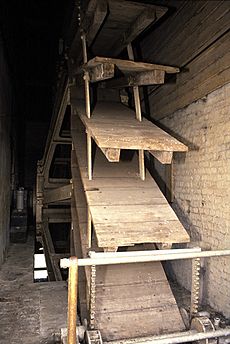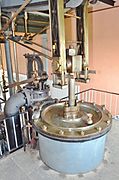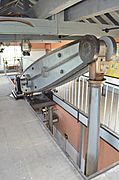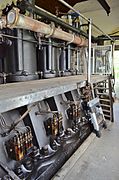Stretham Old Engine facts for kids
Quick facts for kids Stretham Old Engine |
|
|---|---|
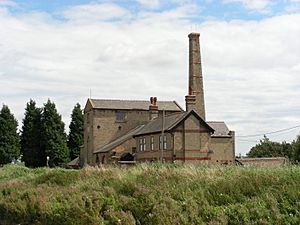 |
|
| Location | Stretham |
| Area | Cambridgeshire |
| Built | 1831 |
|
Listed Building – Grade II*
|
|
| Official name: Old Engine House | |
| Designated | 13 May 1988 |
| Reference no. | 1127031 |
| Lua error in Module:Location_map at line 420: attempt to index field 'wikibase' (a nil value). | |
The Stretham Old Engine is a huge steam-powered machine located near Stretham in Cambridgeshire, England. Its main job was to pump water out of the The Fens, which are low-lying, often flooded areas. This water was then sent into the River Great Ouse.
This engine is very special because it's one of only three old drainage engines still left in a region called East Anglia. It's also a "Grade II* listed building," which means it's an important historical site that needs to be protected.
Contents
The History of Draining The Fens
For hundreds of years, people have tried to drain the wet fenlands in East Anglia. In the 1600s, large areas were drained so people could farm the land.
However, the land often sank after being drained. This meant that crops and farm animals were still washed away by big floods.
Windmills and Steam Power
At first, people used windpumps, which are like windmills, to pump water away. But these pumps depended on the wind and weren't strong enough for huge floods.
Then, in the late 1700s, steam power was invented. This new technology offered a much better way to move large amounts of water. Soon, steam engines started appearing all over The Fens.
How the Stretham Steam Engine Worked
The Stretham Old Engine was built in 1831 by a company called Butterley Company. It cost a lot of money back then – £4950! This powerful engine replaced four old windmills nearby.
For over 100 years, its giant scoop wheel successfully lifted water from flood channels. It moved the water back into the river, keeping the land drier.
Powering the Engine
The engine ran on coal, which was brought to it by barges. It used a lot of fuel, burning about a ton of coal every four hours!
The main part of the engine was a "rotative beam engine." It had a huge beam that was about 7.5 meters (24 feet 8 inches) long. It also had a massive flywheel, about 7.3 meters (24 feet) across.
The Scoop Wheel's Growth
The scoop wheel that the engine turned got bigger over time. This was because the fenland kept sinking.
- The first wheel was 8.8 meters (29 feet) wide.
- In 1850, it was made larger to 10 meters (33 feet).
- By 1896, it grew to 11.3 meters (37 feet 2 inches).
This huge wheel could lift between 120 and 150 tons of water every minute!
Engine Supervision
Running the engine needed constant attention. The stoker (who fed the coal) and the superintendent had to be ready 24 hours a day. One superintendent even had a telescope in his window. This allowed him to watch the workers without getting his feet wet!
The Engine's Replacement
In 1924, a new Mirrlees diesel engine was installed. This meant the steam engine was no longer the main pump. It was kept as a "standby" engine, ready to be used if needed.
The last time the steam engine was used seriously was during big floods in 1939 and 1940. Today, the Prickwillow Museum has a very similar diesel engine that you can see working.
Eventually, the pumping station was replaced again. Five smaller, more efficient electric pumps now do the job. These pumps drain water into the River Cam and are still used today.
Visiting the Stretham Old Engine
You can visit the Stretham Old Engine and see this amazing piece of history for yourself! It is open to the public on Sunday afternoons and Bank Holidays. The visiting season runs from the beginning of April to the end of October. You can usually visit between 1:00 PM and 5:00 PM.
Picture gallery
- Interior views
See also


